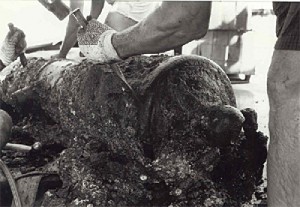 I looked at the the British Sloop Industry Exhibit from the Underwater Archaeology Museum. The authors, Chuck Meide (Director, Lighthouse Archaeological Maritime Program) and Sam Turner (Director of Archaeology, LAMP) identify themselves in the introduction and provide a list of acknowledgments on the credits page (which is, perhaps significantly, a separate page.) The webmaster, T. Kurt Knoerl, is listed at the bottom of the page. In the pictures that follow, none of the people are identified by name (attention is paid to the artifact or process being depicted), nor are the photographers identified. Self-erasure from the record is not the most reflexive method, even if a crew list is provided in the credits.
I looked at the the British Sloop Industry Exhibit from the Underwater Archaeology Museum. The authors, Chuck Meide (Director, Lighthouse Archaeological Maritime Program) and Sam Turner (Director of Archaeology, LAMP) identify themselves in the introduction and provide a list of acknowledgments on the credits page (which is, perhaps significantly, a separate page.) The webmaster, T. Kurt Knoerl, is listed at the bottom of the page. In the pictures that follow, none of the people are identified by name (attention is paid to the artifact or process being depicted), nor are the photographers identified. Self-erasure from the record is not the most reflexive method, even if a crew list is provided in the credits.
The introduction provides a historical context concerning Industry’s activities before it embedded itself in a sandbar in St. Augustine’s Harbor in 1764 (St. Augustine being, unfortunately, the sloop’s final destination), and the ship’s subsequent discovery by Southern Oceans Archaeological Research, Inc. in 1997. The historical background gives a strong narrative of “discovering” and “colonization”, and mention of indigenous settlements is peripheral. This surprised me, as one panicky primary source reported that the beached ship (heavy with artillery and weapons) had been ransacked by Timucuan Indians, such that locals were now fearing all-out warfare. Certainly this is significant! “Today there are no known Native Americans who call themselves Timucuan”, but there must be ways to delve back into the record (archaeological or historical) to integrate that part of the story.
The methodology section provides an interesting account of how looting changes the archaeological process (but in an oddly disaffected way) and includes original surveys, but the jargon is not always explained. The findings section does not contain a full catalogue (a link to a dissertation on Industry provides a larger report), but each item is accompanied by a description, pictures, and historical context, making it the easiest to understand. However, this setup exactly mirrors what one might encounter in a museum, so I am not entirely sure what the online experience “adds” (other than helpful links to said dissertation and LAMP’s website, which are indeed helpful to have as immediate resources.)
SOAR worked to engage the general public through articles, high school internships (providing students with generalized training in nautical studies, museum practice, and public interpretation as well), television segments, and public talks. A section titled “Conservation” shows schoolchildren around a cannon submerged in a tank of water, speaking to the conservation of artifacts as well as public interest.
